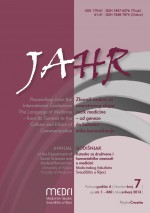The cult of saints-healers – an alternative and opposition to the official medicine in medieval Bulgaria
Abstract
Medieval Bulgarian medicine from the iX-Xv c. was characterized by the low occurrence of medical services, by their inaccessibility, as well as by the widespread disappointment in learned physicians. This led to the search for alternative healing practices. different means and methods were developed for filling up the deficit of healthcare services:• Self-treatment and self-proclaimed healers, • Healing through sacred objects, • Faith in saints and their relics. evidence of the existence of a Bulgarian tradition of healing practices can be found in the considerable number of medical medieval works of utilitarian application, such as manuals, intended to be used by both – healers and patients. Pagan practices of worshipping magic items were transformed into the worship of objects of religious function – the cross, the Scriptures, holy water, holy oil, icons, etc., to which miracu-lous healing and saving powers were attributed. The cult of saints is highly utilitarian and focuses on the meeting of health care needs. Thus a parallel between self-proclaimed healers and saints was drawn, as saints were also believed to have been able to cure the faithful through god’s power. This cult has two aspects: • their supernatural powers, which the Saints had while still alive and • the miracles, associated with their relics. in the primitive medieval health care system, primary medical practice was not entrusted to the medical professionals, but to the saints-healers and their relics. Seeking assistance and treatment from them was also a way to deny scientific medicine.
Downloads
Published
Issue
Section
License
Authors who publish with this journal agree to the following terms:
- Authors retain copyright and grant the journal right of first publication with the work simultaneously licensed under a Creative Commons Attribution License that allows others to share the work with an acknowledgement of the work's authorship and initial publication in this journal.
- Authors are able to enter into separate, additional contractual arrangements for the non-exclusive distribution of the journal's published version of the work (e.g., post it to an institutional repository or publish it in a book), with an acknowledgement of its initial publication in this journal.
- Authors are permitted and encouraged to post their work online (e.g., in institutional repositories or on their website) prior to and during the submission process, as it can lead to productive exchanges, as well as earlier and greater citation of published work (See The Effect of Open Access).



